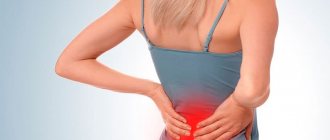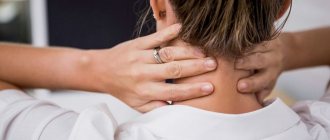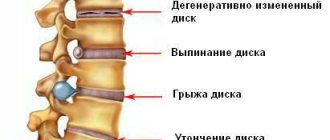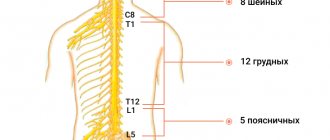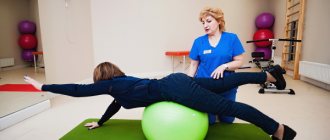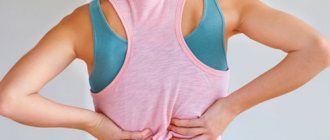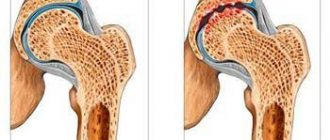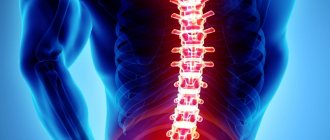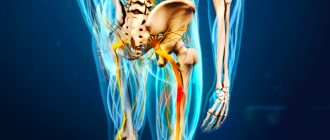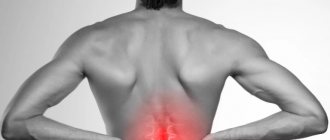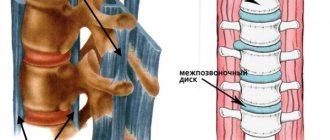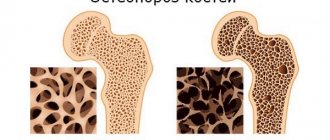Lower back pain in women can occur for a variety of reasons. Among them there are both physiological and pathological. Therefore, it is important to figure out when to sound the alarm and see a doctor, and when it is enough to give your back a rest for a few days. But since many diseases accompanied by back pain can cause severe complications and even disability, you should be very careful about your health and, if signs of deviation from the norm appear, make an appointment with a doctor as soon as possible.
Physiological causes of lumbar pain in women
One of the common causes of lower back pain in women is overstrain of the back muscles due to prolonged sitting, standing or physical work. In such situations, lactic acid is produced in increased quantities, which causes characteristic discomfort. In such situations, it is necessary to provide your back with rest for several days.
The well-being of women directly depends on hormonal levels, which change not only during puberty, pregnancy and menopause, but also monthly. Therefore, many women experience aching or nagging pain in the lower back every month on the eve of menstruation or directly during it.
This kind of discomfort is also typical during menopausal changes. As the level of estrogen progressively decreases, and the amount of other hormones increases, this cannot but affect your well-being. Classic manifestations of the beginning of the decline of a woman’s reproductive function are the appearance of so-called hot flashes, mood swings and fluctuations in blood pressure. Sometimes this can also be accompanied by lower back pain, but more often this kind of discomfort in older women indicates the development of spinal pathologies.
Low back pain during pregnancy deserves special attention. During this important period in a woman’s body, in addition to serious hormonal changes, a lot of other changes occur. Thus, the uterus gradually enlarges, which over time leads to an increase in the deflection in the lower back and a shift in the center of gravity. In addition, weight increases, which also creates additional stress on the spine. All this together can provoke the occurrence of lower back pain of varying severity both in the early stages of pregnancy and at the end. In this regard, it is very important to put the spine in order. Our clinic has developed and prepared a special program of comprehensive examination and treatment for pregnant women and those planning pregnancy.
The norm for pregnant women is considered to be aching pain in the lumbar region, which goes away after rest. They mainly occur during physical activity or long walking, but should not be accompanied by nagging pain in the lower abdomen and the appearance of brownish vaginal discharge. Such signs may indicate a risk of miscarriage or premature birth and require immediate contact with a doctor managing the pregnancy.
Due to the changes that occur in a woman’s body during pregnancy, chronic diseases often worsen at this time or new ones arise; the spine is especially often affected. Therefore, lower back pain may also indicate them.
In all the cases described above, fluctuations in hormonal levels are natural, therefore, mild, aching lower back pain in women is regarded as a variant of the norm. But if certain disorders are already present in the body, physiological fluctuations in hormonal levels can lead to their aggravation and the emergence of a number of diseases, some of which can also manifest as back pain. Therefore, it can be very difficult for women to independently differentiate the symptoms of banal muscle fatigue, hormonal changes from signs of pathology. In this regard, it is recommended to make an appointment with a doctor if non-pregnant women experience weak, aching pain more than 2 times a month. Also, examination by a specialist is required for ladies with acute pain syndrome.
When you need to see a doctor urgently
Many people are skeptical about one-time and occasional back pain. But to avoid complications, you need to consult a therapist. You should not delay going to the clinic if you have the following symptoms:
- taking antispasmodics does not help improve the condition;
- pain persists for 2–3 days and may occur at night;
- pain syndrome is not associated with high physical activity;
- body temperature increases;
- there is abnormal vaginal discharge/blood or pus in the urine;
- pain radiates to the lower abdomen, various parts of the body and internal organs;
- urination is painful, mixed with blood;
- numbness of the limbs is periodically felt.
Pathological causes of lower back pain in women
Many diseases manifest themselves as back discomfort. Among the most common are pathologies of the lumbosacral spine, kidneys, uterus and appendages. Moreover, in terms of frequency of occurrence, disorders of the spine lead.
Diseases of the kidneys and genital organs can be differentiated from pathologies of the musculoskeletal system by increased frequency of urination and the appearance of painful sensations, the presence of pain in the lower abdomen, changes in the menstrual cycle, and unusual vaginal discharge.
Spinal diseases are more characterized by the isolated presence of lower back pain. At later stages, they may be accompanied by the addition of radicular syndrome, i.e., irradiation of pain in the legs, buttocks, as well as numbness, impaired sensitivity, and mobility of the legs.
By the way, most pathologies of internal organs, including the uterus with appendages, kidneys and others, are caused by changes in the spine, since even minor curvatures or degenerative processes in it lead to disruption of segmental innervation. Therefore, the transmission of nerve impulses from the part of the spinal cord corresponding to the level of damage to a specific organ is disrupted, which initially causes disturbances in its functioning, and then leads to the development of organic changes, i.e., the occurrence of one or another chronic disease. Poor circulation in the lumbar spine leads to decreased nutrition in the lower extremities and pelvic organs. In the absence of appropriate treatment, a number of diseases can develop - sexual dysfunction, amenorrhea, dysmenorrhea, thrombophlebitis, etc.
So, the most common spinal diseases that cause lower back pain in women are:
- Osteochondrosis of the lumbosacral spine, protrusion and intervertebral hernia are the most common pathologies of intervertebral discs, accompanied by degenerative changes, a decrease in their height and, over time, deformation of the shape, i.e. the formation of a protrusion, and then a hernia. This leads to pain of varying intensity in the lumbar region, which intensifies with movement, prolonged sitting, etc. The situation is often complicated by compression of the spinal nerves, which leads to pain in the legs, buttocks, and feet.
- Spondylosis is a complication of osteochondrosis, in which there is the formation of bony protrusions at the edges of the vertebral bodies, which over time can fuse with each other, making the affected spinal motion segment completely immobilized.
- Scoliosis is a curvature of the spine in the lateral plane, accompanied by the occurrence of asymmetry of the shoulder blades and pelvis. It can progress and have a significant negative impact on all internal organs.
- Myofascial syndrome is a disease in which physical activity or pressure on certain points leads to acute attacks of pain. It does not pose a serious threat to health, but significantly reduces the quality of life.
- Ankylosing spondylitis is a systemic disease in which intervertebral discs ossify, forming bone conglomerates with neighboring vertebrae, which leads to pinched nerves and significant limitation of mobility.
- Spinal fractures - most often occur in older women due to osteoporosis, and in young women after a fall, blows, etc. They are fraught with acute pain, changes in posture and the development of a number of complications. They require competent, timely assistance.
Much less often, lower back pain is caused by the formation of benign or malignant tumors of the spine or the appearance of metastases in the presence of tumors in other organs.
Women who are most predisposed to lower back pain are:
- with large breast size;
- having excess weight;
- leading a sedentary lifestyle;
- those performing heavy physical work, forced to regularly lift weights;
- tend to slouch;
- wearing uncomfortable high-heeled shoes for a long time.
Lower back pain in women can be of varying severity and nature. The reason for mandatory consultation with a doctor is acute pain or pain that occurs more than 2 times a month.
Diagnosis of the causes of lower back pain in women
If you experience lower back pain in combination with urination problems, the menstrual cycle, discomfort in the lower abdomen and other similar signs, you should consult a urologist or gynecologist. If there are signs of spinal diseases described above, you should immediately make an appointment with a chiropractor, neurologist or vertebrologist.
If it is difficult for a woman to independently figure out what caused the pain in the lower back, she is recommended to consult a therapist who will conduct an examination and prescribe laboratory tests and ultrasound, based on the results of which she will refer the patient to a specialist.
At the appointment, the chiropractor will conduct a thorough interview and examination of the woman, and will also use certain neurological tests. This will allow him to assess the degree of damage to the spine and make a preliminary diagnosis, which requires clarification using modern instrumental methods:
- X-ray;
- CT;
- MRI;
- electroneuromyography, etc.
The most informative and safe method for diagnosing pathological changes in the spine is MRI. This type of diagnosis allows you to detect the slightest deviations from the norm and thoroughly study the condition of the intervertebral discs, spinal cord and detect an area of compression of the spinal root. All this helps to create the most correct treatment tactics, which will give maximum results in the shortest possible time.
In our clinic, you can also learn in more detail about the composition of your body and the state of the vascular system, which is involved in the blood supply to internal organs, skeletal muscles, and the brain. Our experienced doctors will explain the data obtained to you in detail. Bioimpendansometry calculates the ratio of fat, muscle, bone and skeletal mass, total fluid in the body, and basal metabolic rate. The intensity of recommended physical activity depends on the state of muscle mass. Metabolic processes, in turn, affect the body's ability to recover. Based on the indicators of active cell mass, one can judge the level of physical activity and nutritional balance. This simple and quick test helps us identify disturbances in the endocrine system and take the necessary measures. In addition, it is also very important for us to know the condition of blood vessels for the prevention of diseases such as heart attacks, hypertension, heart failure, diabetes and much more. Angioscan allows you to determine such important indicators as the biological age of blood vessels, their stiffness, stress index (which indicates heart rate), and blood oxygen saturation. Such screening will be useful for men and women over 30, athletes, those undergoing long-term and severe treatment, as well as everyone who monitors their health.
In this case, body composition analysis gives us information that adipose tissue predominates in the body, and the bone-muscle component is in relative deficiency. These data will help the rehabilitation doctor competently draw up a physical activity plan, taking into account the individual characteristics of the patient.
Diagnostic measures
After a complete examination of the body, the doctor will be able to make the correct diagnosis and find out the reason why a woman’s back hurts, and what help she needs in this situation. In order to begin treatment, it is worth undergoing a number of examinations, namely:
- clinical blood test;
- clinical urine analysis;
- electrocardiogram;
- X-ray examination;
- ultrasound diagnostics of all organs;
- computed tomography of the spine along the entire length.
After a complete examination of the body, the attending physician will determine the reason why your back hurts, and then prescribe the necessary treatment and its duration. Most often, therapy includes therapeutic exercises, medications, and, if necessary, surgery.
Therapeutic gymnastics at home should be carried out after consultation with a doctor
Conservative treatment of low back pain in women
After determining the cause of the development of pain and obtaining accurate information about the degree of neglect of pathological changes, the woman is prescribed treatment. In most cases, complex conservative therapy is initially proposed, which includes:
- drug treatment;
- osteopathy;
- manual therapy;
- massage;
- physiotherapeutic procedures (phonophoresis, carboxytherapy, ozone therapy, RF current pressure therapy);
- individual sessions with a rehabilitation specialist.
For each patient, treatment tactics are developed individually. In this case, not only the diagnosis is taken into account, but also the presence of concomitant diseases, the woman’s age and other factors. Naturally, the treatment of diseases of the kidneys and reproductive organs will be very different from the treatment of spinal pathologies. But since they are almost always combined, let’s talk in more detail about the treatment of spinal diseases, since it is always more complex and more multifaceted, and their elimination leads to improved functioning of internal organs and a significant increase in the effectiveness of the treatment.
All women are definitely advised to reconsider their lifestyle and eating habits. If you are overweight, it is recommended to reduce it as much as possible. Refusal of unhealthy and fatty foods and replacement with fresh fruits and vegetables that are healthy for the body will not only normalize body weight, but will also have a beneficial effect on the condition of the spine.
It is also recommended to normalize the level of physical activity, i.e., when working “sedentarily”, it is recommended to take a short break every hour to warm up. It is necessary to stop lifting and carrying heavy objects, and it is also advisable to purchase an orthopedic mattress and pillow.
It is very important to consult a doctor and start treatment as early as possible, when lower back pain first appears. This will significantly speed up and facilitate therapy and achieve complete recovery. In complex, advanced cases, spinal pathologies are treated only surgically.
Drug therapy
Drug treatment for each patient is developed strictly individually. It often includes drugs from several pharmacological groups, the combination of which can improve a woman’s well-being and eliminate the causes of its deterioration. Most women are recommended to take:
- NSAIDs are non-steroidal anti-inflammatory drugs with analgesic properties, available in many dosage forms, which allows you to choose the optimal route of administration for the situation;
- corticosteroids are hormonal drugs that have a powerful anti-inflammatory effect and are prescribed in short courses;
- muscle relaxants - medications that help eliminate muscle spasms, which leads to a reduction in pain;
- chondroprotectors are drugs prescribed at the earliest stages of the development of degenerative processes in the intervertebral discs and allowing them to be restored to their normal state. To prevent diseases of the musculoskeletal system, we recommend to our patients the most effective drug Mermaids Marine Collagen;
- B vitamins – improve nerve conduction;
- vitamin D is a remedy responsible for the condition of bone tissue, as well as for higher brain functions, such as memory, attention, speech.
For very severe pain that cannot be eliminated with traditional medications, women can undergo blockades - injections of anesthetic solutions with corticosteroids. But such procedures are associated with risks, have contraindications and are effective only for pain of neurological origin.
Manual therapy
Manual therapy can be called the basis for the treatment of spinal diseases of varying severity. By using the techniques that are most appropriate for a particular case, especially those belonging to Gritsenko’s original technique, it is possible to achieve a lasting and significant improvement in well-being, as well as directly influence the spine, restoring its normal anatomy. There are no general standards of treatment in our clinic; an individual approach is applied to each patient.
Manual therapy allows you to:
- restore the correct position of the vertebrae and increase the distance between them, which has a positive effect on the condition of the intervertebral discs;
- eliminate compression of the spinal roots and radicular syndrome;
- eliminate muscle spasms and normalize muscle tone;
- improve blood circulation and tissue trophism;
- increase immunity and adaptive capabilities of the body.
Manual therapy is not contraindicated during pregnancy. Moreover, sessions can improve the condition of the woman and fetus, as well as reduce the risks of various perinatal disorders.
Improvement in well-being is observed after the first session. But to consolidate the achieved result, it is necessary to complete the entire course of treatment prescribed by the chiropractor.
Physiotherapeutic procedures
In order to increase the effectiveness of treatment outside the acute period, women are prescribed physiotherapeutic procedures:
- electrophoresis;
- ultrasound therapy;
- traction therapy;
- UHF;
- laser therapy, etc.
The duration of the course and frequency of procedures is selected separately for each patient.
Exercise therapy
Therapeutic exercise is an essential element of treatment, helping to strengthen muscles and improve blood circulation. A set of exercises is developed individually by a rehabilitation doctor, taking into account the woman’s age and physical fitness. The first classes are conducted under the supervision of a specialist, and after the final mastery of the methodology for performing each exercise, you are allowed to practice at home. But the key to the effectiveness of exercise therapy is regularity. Therefore, you need to practice every day.
Thus, lower back pain in women can be harmless or a sign of a serious illness. Therefore, in order to accurately establish the cause and not mistake the symptom of pathology for banal overwork, you should consult a doctor. This will be the key to early diagnosis of diseases and effective treatment.
4.5 2 votes
Article rating
Diseases of the spine and joints
Osteoporosis
This is the most common cause of pain in women. With age, bone tissue becomes fragile and brittle. During menopause, women stop releasing the hormone estrogen, which is responsible for preserving bone tissue. At the same time, the vertebrae lose their elasticity and are often deformed. Osteochondrosis occurs, which affects the intervertebral discs and surrounding tissues.
To prevent osteoporosis, women are recommended to perform special physical exercises to strengthen their muscles and take calcium supplements. In addition, it is worth reducing or stopping the consumption of caffeine, alcohol and nicotine to avoid rapid depletion of bone tissue.
Arthrosis, arthritis, and back pain significantly worsen our quality of life. Sometimes it is simply impossible to calmly raise your arm, step on your leg, or get out of bed without experiencing pain and discomfort.
Diseases of the vertebrae and intervertebral structures often develop in older people - they belong to the group of degenerative-dystrophic pathologies and tend to progress slowly, periodically exacerbating (in the off-season). It happens that diseases of the spine appear in childhood or at a young age and can be caused by infection (tuberculosis), poor posture (scoliosis), and can also be inherited (Bechterew's disease).
